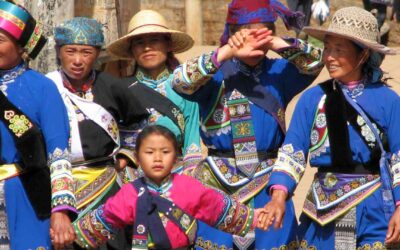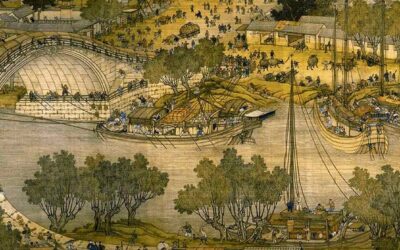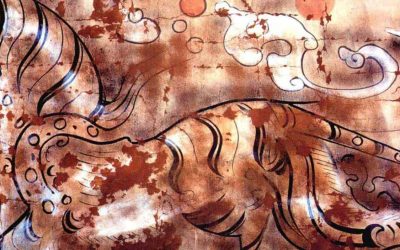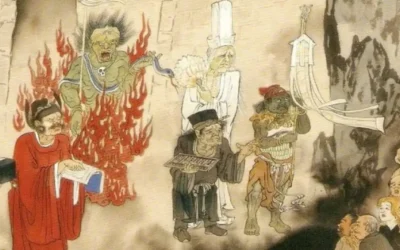Did a Taoist Art of the bedchamber of male Homosexuality Exist?
This is the question posed by Zhang Wanrong in an intriguing article published last year in the journal Religions[1].
The Taoist Art of the bedchamber
For those unfamiliar with the topic, among the techniques for achieving immortality—practices intended to preserve health and attain longevity—was the so-called Taoist sexuality or Art of the bedchamber. It was based on altering the balance of yang and yin energies in favor of the man. Essentially, Taoists proposed that men could enhance their yang life energy by engaging in intercourse with multiple women, especially young or virgin women, who were believed to possess strong yin or feminine energy. By controlling their ejaculation and not losing their yang essence, they would continuously accumulate yang, ultimately achieving long life and potential immortality.
Some of the classic texts that formed the basis of these theories even recommended group sex and encouraged practitioners to have relations with numerous very young women.
Homosexual Love in 17th-Century China
On the other hand, it is well known that during the late Ming dynasty and the early Qing dynasty—essentially from the 17th to the 19th century—there was a tremendous wave of male homosexual love in China. While there are already records of homoerotic relationships between various emperors and their favorites or eunuchs—indeed, the Book of Han (Hanshu) mentions favorites who would sleep and wake with the emperor—during this period, homosexuality became fashionable among scholars and the upper classes. Many intellectuals sought young boys to satisfy their pleasures, though relationships between equals also existed.
Erotic Novels with Homosexual Themes
According to Mr. Zhang, some writers of erotic novels with homosexual themes may have attempted to provide a sort of health-based justification for these practices by incorporating them into the Taoist Art of the bedchamber. They claimed that young boys under the age of twenty had not yet developed yang energy and could therefore be grouped with young girls, in whom yin energy predominated. Consequently, sexual relations with them were purportedly just as beneficial for health as relations with women. However, no medical texts support this claim.
As fundamental references, some novels from that period include Yichun Xiangzhi (The Fragrance of Quality of the Good Spring) and Feng Shuangfei (Two Phoenixes Flying Together), as well as descriptions of the life of a famous Taoist, Ma Zhenyi (馬真一), who, interestingly, employed both elderly women and very young boys in his immortality techniques.
A Cultural Justification
As we can see, there is no strong historical foundation for the existence of a homosexual Art of the bedchamber among Taoists. However, as the author points out, this notion at least provided a culturally and health-based justification (as some narratives traced its origins to alleged homosexual relations between Laozi and Xin Yi, the guardian of the Western Pass for whom he wrote the Daodejing) for those who practiced it.
Regarding the passive partner in these relationships, one novel (Bian’er Chai—Cap and Hairpin) even offers a health-related justification, depicting a protagonist who nourishes his yang when having relations with women and his yin when with men.
It is certainly an intriguing and thought-provoking proposition. Future research may confirm or refute it, but in the obscure realm of the history of sexuality in classical China, it remains, at the very least, a bold hypothesis.
[1] Zhang Wanrong. The Daoist Art of the Bedchamber of Male Homosexuality in Ming and Qing Literature. Religions, 15: 841. 2024.
About me: I have spent 30 years in China, much of the time traveling and studying this country’s culture. My most popular research focuses on Chinese characters (Chinese Characters: An Easy Learning Method Based on Their Etymology and Evolution), Matriarchy in China (there is a book with this title), and minority cultures (The Naxi of Southwest China). In my travels, I have specialized in Yunnan, Tibet, the Silk Road, and other lesser-known places. Feel free to write to me if you’re planning a trip to China. The agency I collaborate with offers excellent service at an unbeatable price. You’ll find my email below.
Last posts
An Old Book on the Sani-Yi Minority
An Old Book on the Sani-Yi Minority One may wonder whether it makes any sense to read, in the first decades of the 21st century, a book written at the end of the 19th. Clearly, the person who has spent some of their time translating it, revising it, updating the old...
Praise for the book on Chinese characters
Praise for the book on Chinese characters Good News! I'm happy to share that my book Chinese Characters: An Easy Learning Based on Their Etymology and Evolution has been selected by BookAuthority.org as one of The Best Etymology Books for Beginners! BookAuthority...
The Qingming Festival: From Spring Celebration to Festival of the Dead
The Qingming Festival: From Spring Celebration to Festival of the Dead The Qingming Festival (清明节) is today China’s Day of the Dead—the time when people remember their deceased relatives and travel to cemeteries located on the outskirts of cities, or to tombs built in...
Linghu Zhuan’s Skepticism Leads Him to the Underworld
Linghu Zhuan’s Skepticism Leads Him to the Underworld Linghu Zhuan was a man of great integrity who did not believe in gods or spirits. Whenever someone spoke of ghostly transformations or divine retribution in the afterlife, he refuted their words with compelling...
Chinese Herbal Medicine Shop in Weishan, Yunnan
Chinese Herbal Medicine Shop in Weishan, Yunnan China still maintains a strong tradition of using natural medicines, specifically herbs with medicinal properties that have been used for centuries. In addition to being present in the composition of many modern...
Treating illnesses with a pillow from under a corpse
Treating illnesses with a pillow from under a corpse In a biography of Xu Sibo[1], a Daoist specialist in water therapy of the fifth century of our era[2], we read: "There lived a matron who had been troubled with incurable constipation for many years, and that Sibo,...










